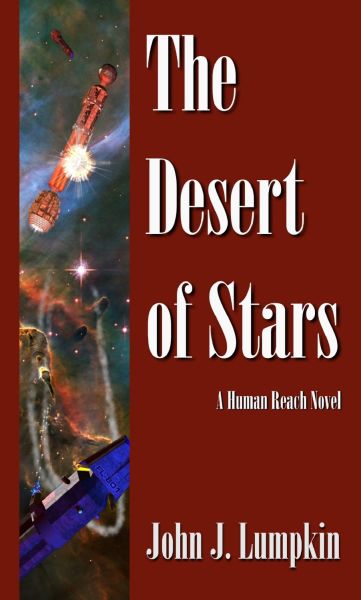The Desert of Stars
The Desert of Stars (Human Reach, volume 2)
By John J. Lumpkin

8 Aug, 2014
0 comments
John Lumpkin’s second novel serves to remind readers that there is such a thing as well-written, carefully thought military science fiction, and that there is no reason why MilSF fans need to settle for sub-par Extruded MilSF Product churned out by a collective of once-greats and never-weres.
This picks up where the previous book left off: Japan and China are embroiled in a vast interstellar war, one triggered by the revelation that the distribution of habitable worlds near the Sun is far less homogenous than previously believed and the luck of the draw has gifted China with a natural route to the richest systems.
China and Japan are each assisted by their own coterie of minor powers1. The United States – faded but still a perfectly respectable second-rank power – has leapt on the chance to pull a Mussolini and drag the US back to glory by joining the winning – Japanese — side of a short victorious war. Nobody told China that they were supposed to fold and so the war drags on. And on.
Despite some scenes on Earth focusing on the attempts by the US to convince neutrals like India to join the anti-China alliance, the main part of the plot involves two extra-solar worlds, both in contention between China and Japan’s expendable proxy America. Lieutenant (j.g.) Neil Mercer, Intelligence Officer and James Donovan, Senior Operations Officer, U.S. National Security Service head to the balkanized world Entente to try to solidify an alliance there while on Kuan Yin, US forces fight a bloody and losing war against the Chinese forces occupying what was once an American-held colony.
Neil and John’s specific goal is convince the dictator of the pocket nation of Tecolote to throw in on the US side but the strong-man proves oddly incapable; rather than being a valuable potential ally it is not clear the dictator can hold onto his nation for much longer. Inexplicably, rampant corruption and brutal oppression has alienated much of the population, and the activities of China’s surprisingly capable intelligence network do not help the US cause.
On Kuan Yin, the Chinese seem to hold all the cards, superior numbers, command of air and near space to a camp full of settlers turned hostage. Despite the best efforts of the US forces, they suffer defeat after defeat, leaving them to hope for external intervention while considering tactics that in better times would be considered clear war crimes.
The same complaints about the compressed time scale I had with the previous book apply to this novel; there’s a plot-driven mismatch between the technology demonstrated by the worm-hole stringing probes and the other space craft. Otherwise, Lumpkin tries very hard to play fair within the constraints on space combat as explicated over at Atomic Rockets; space travel is energy and power hungry and slow at the best of times.
This was considerably grimmer than Through Struggle, The Stars, the book to which it is a sequel; the shades of gray are darker and none of the nations involved come out looking good. There are, however, sympathetic and interesting people on all sides, very few of whom are making high level political decisions.
This ends on a cliff-hanger of fairly large proportions but I still greatly enjoyed the novel and am eagerly awaiting the next book in the series, The Passage of Stars.
Through Struggle, The Stars and A Desert of Stars may be purchased here. They are highly recommended.
- You may ask what Canada is doing during this conflict. War profiteering, as far as I can tell. In 2014, our two main sources of immigrants are China and India (or if you lump Pakistan in with India, India and China) so by the time of the novel there may not be a national consensus on which side to come in on. Or we could be craven, greedy weasels. Really, there are so many plausible choices here.
